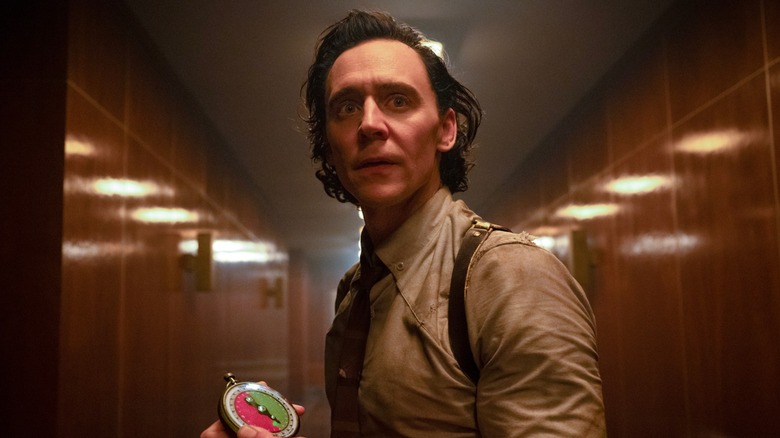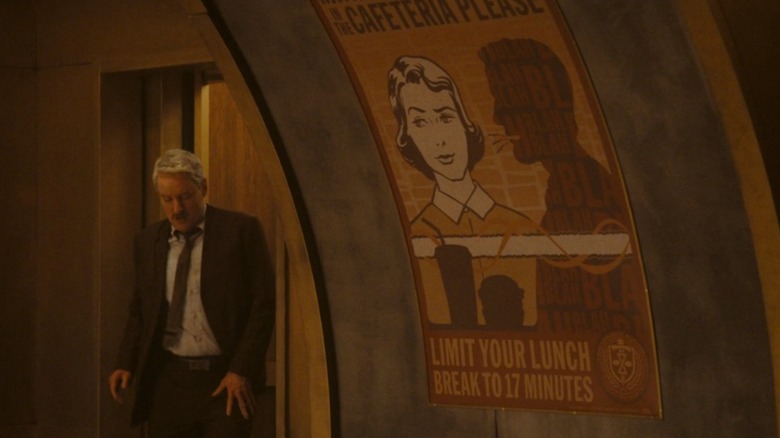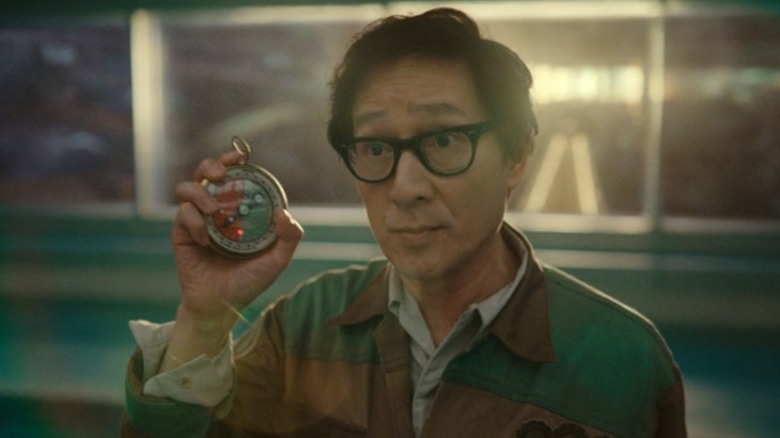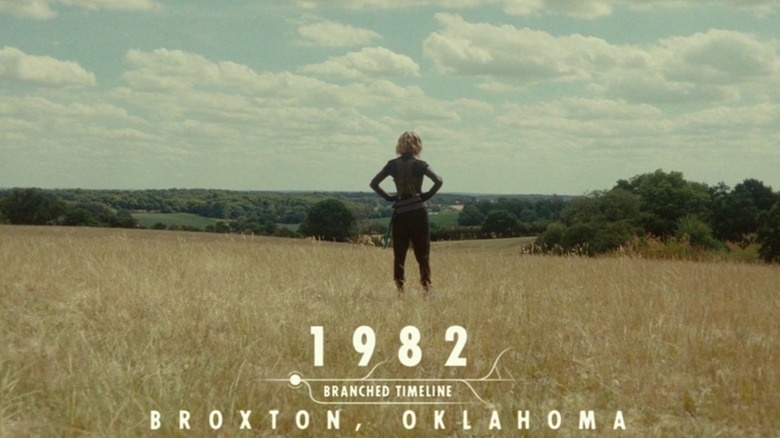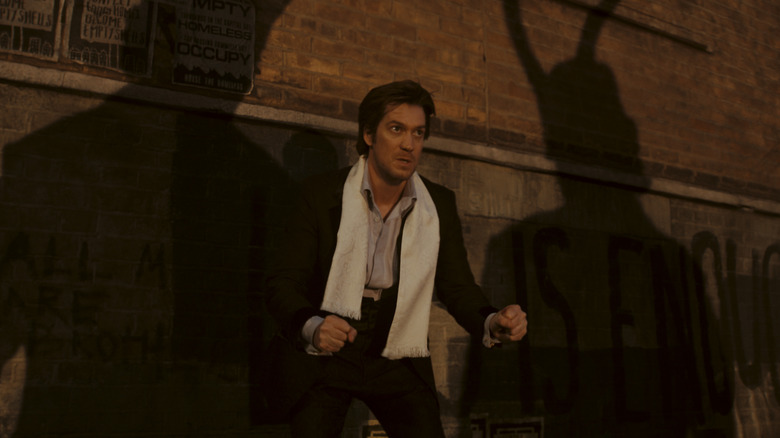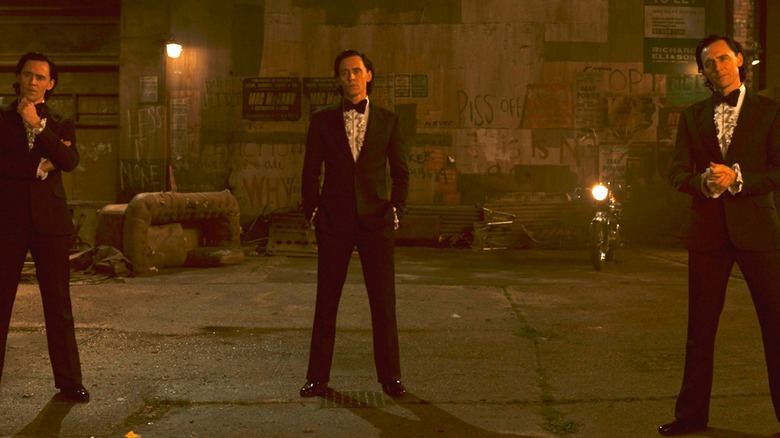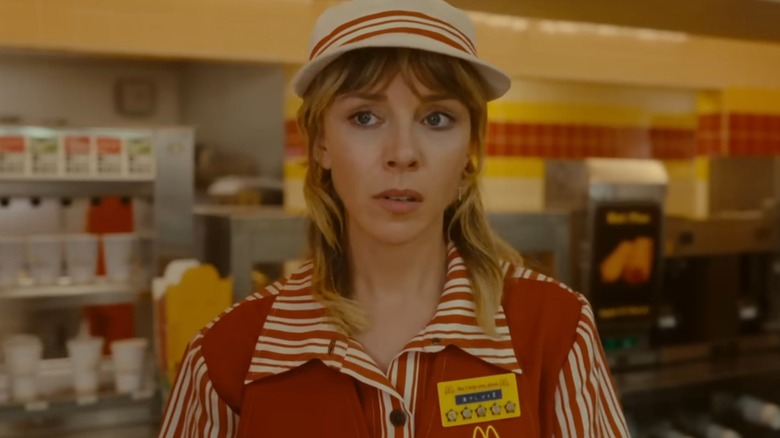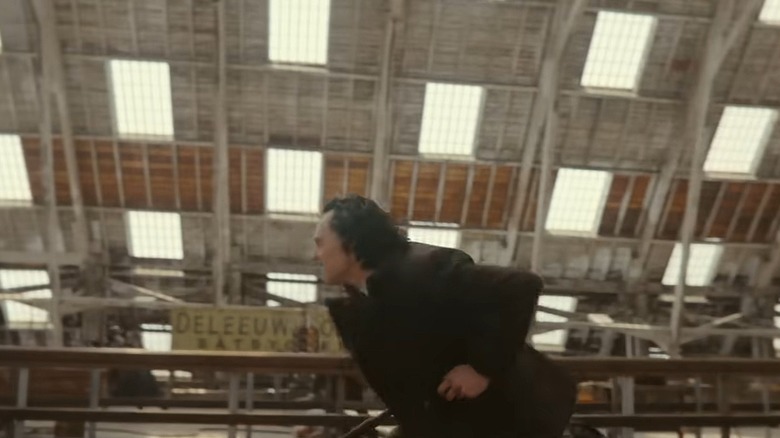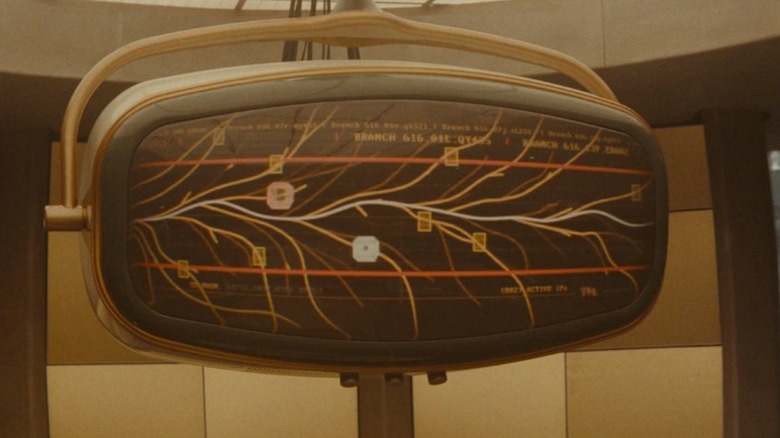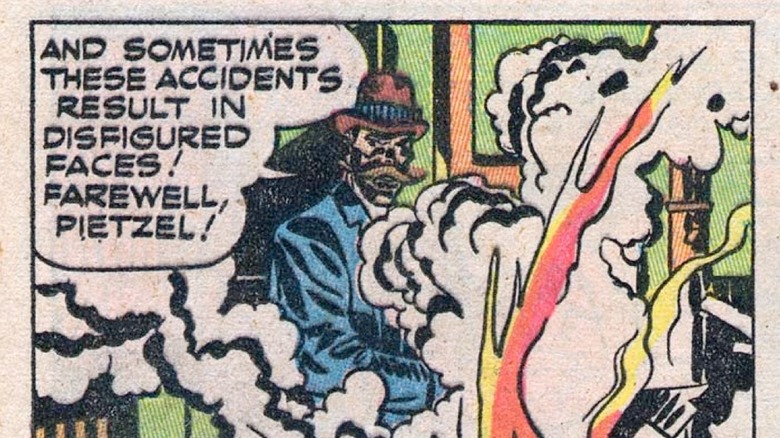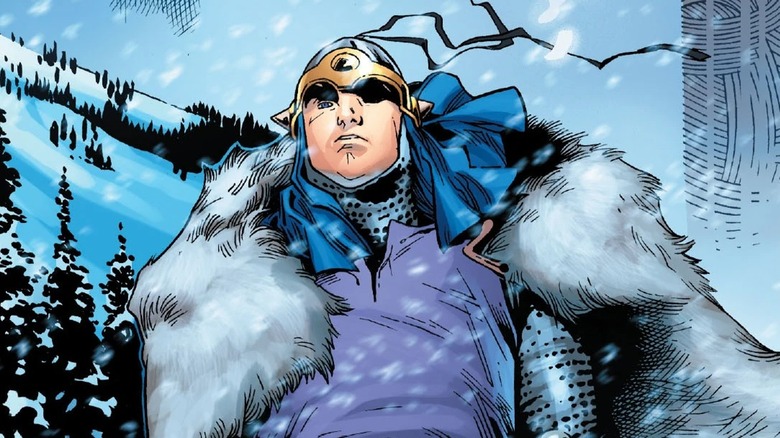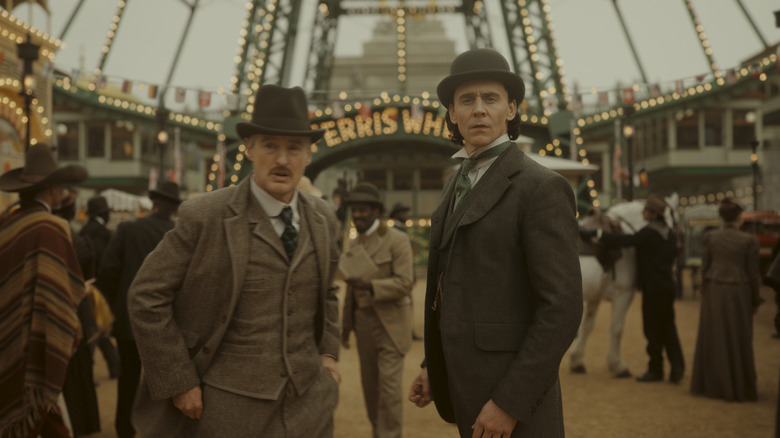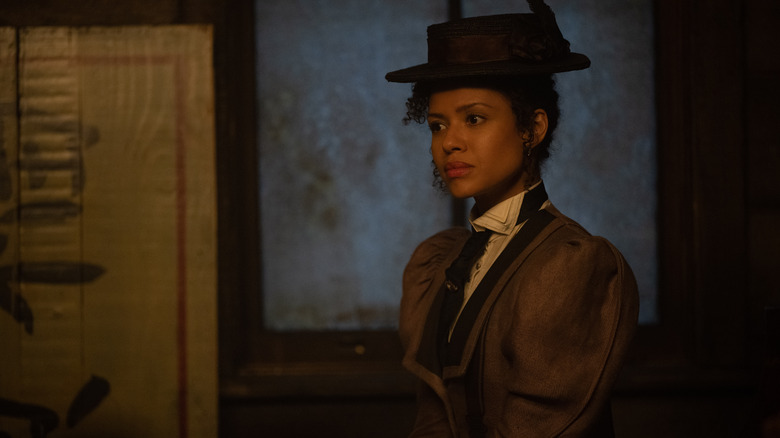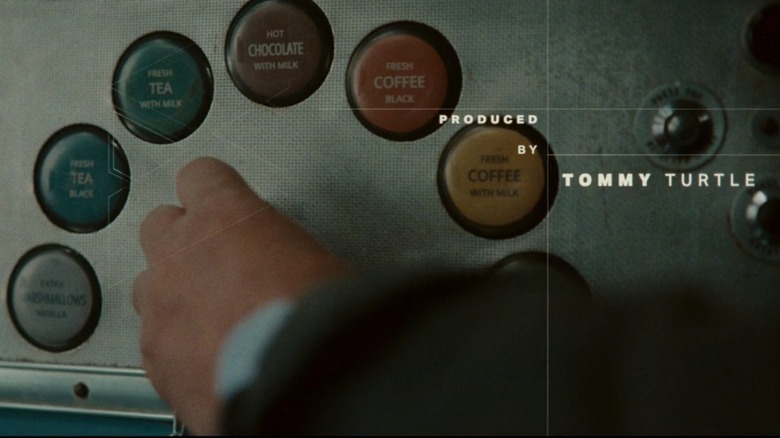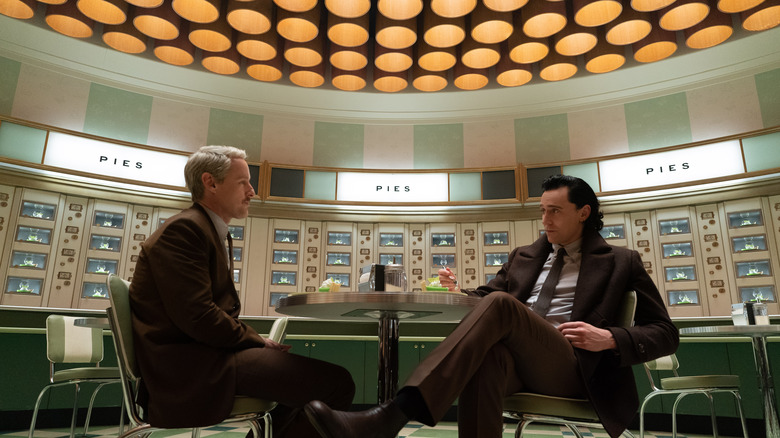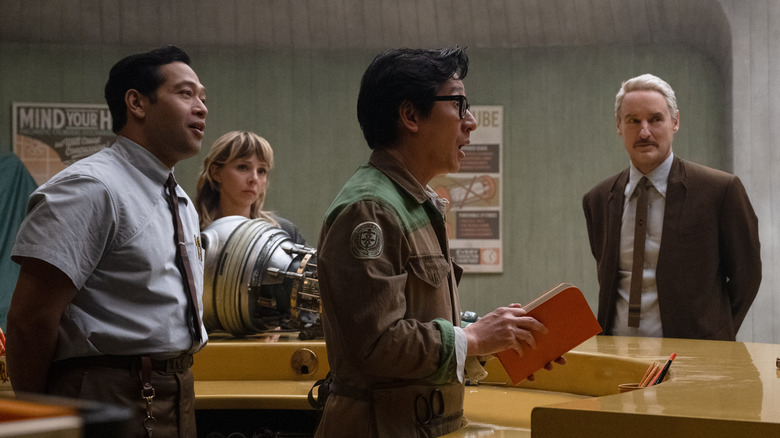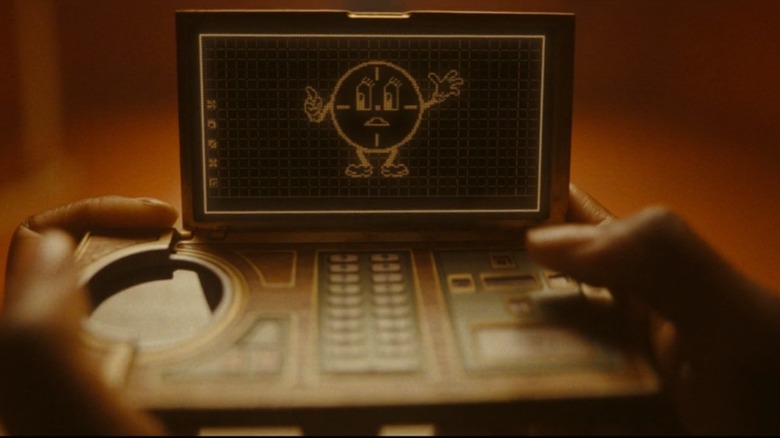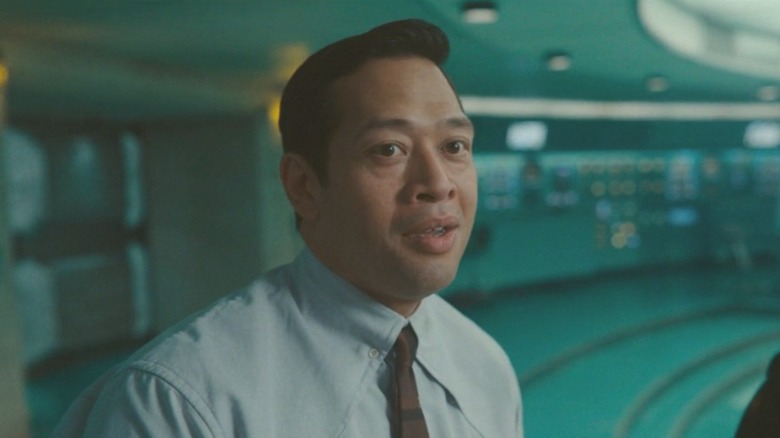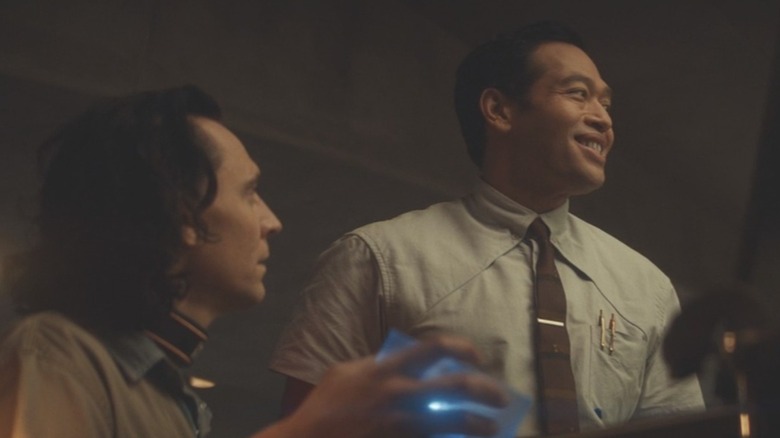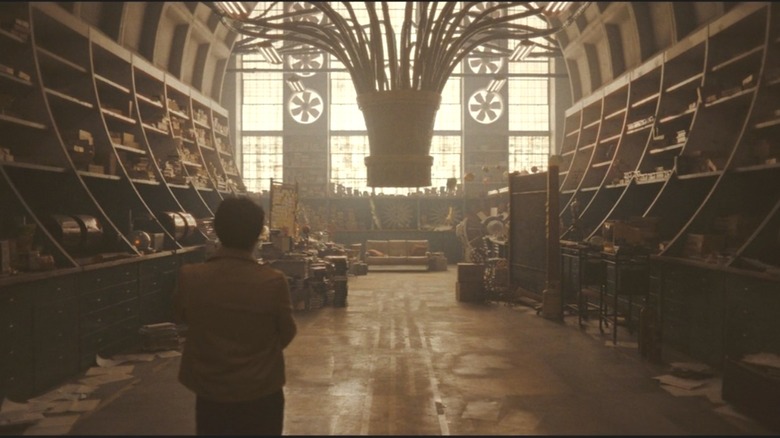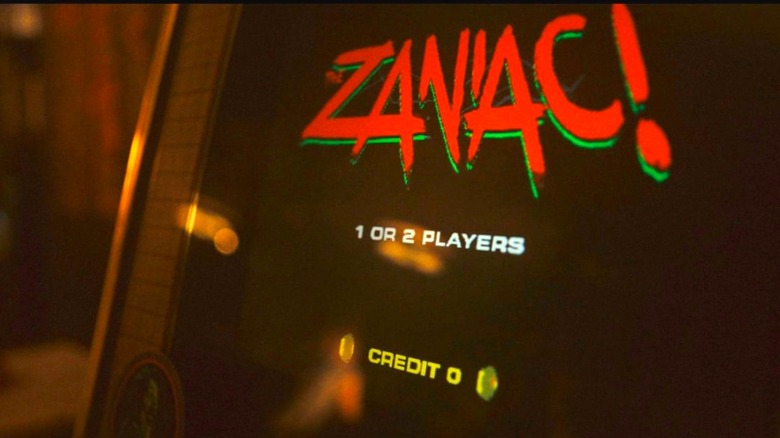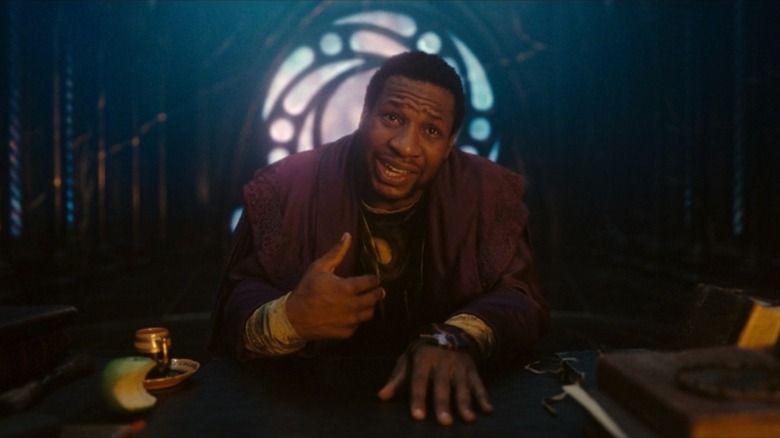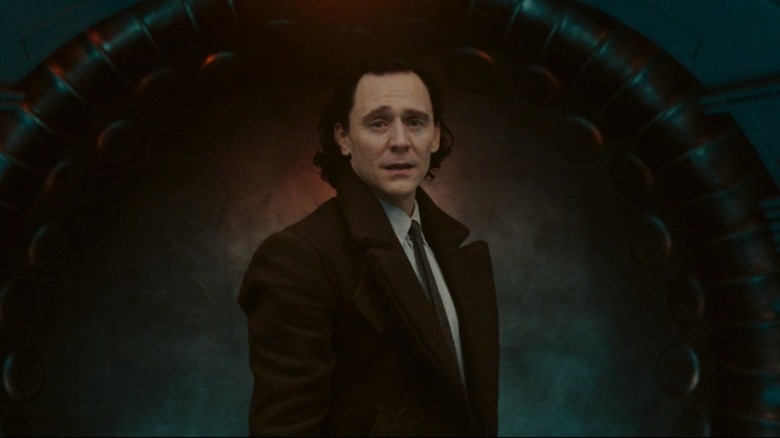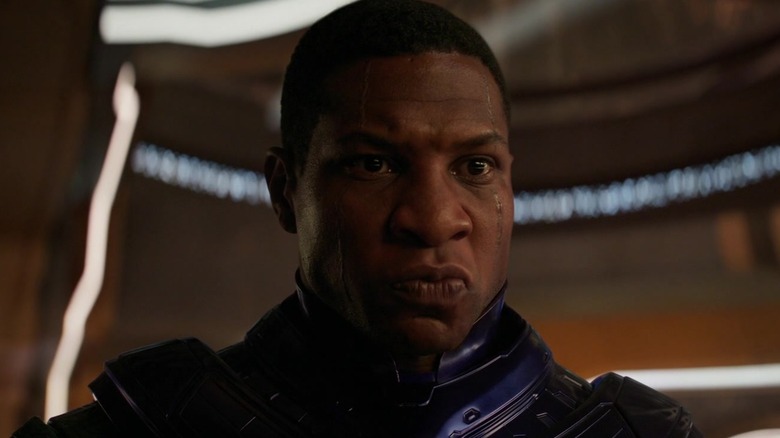Easter Eggs And References You Missed In Loki Season 2
Contains spoilers for "Loki," Season 2
Ever since the first episode of the first season, which showed a bunch of Infinity Stones stuffed in the back of a drawer, "Loki" has established itself as a show in the Marvel Cinematic Universe (MCU) that gleefully includes Easter eggs at every opportunity. Because, really, how could it not, with the multiverse opening up so many possibilities? In the first season alone, there were countless Easter eggs, ranging from a sly nod to "Iron Man" to a homage to the birthplace of Marvel Comics writer Mark Gruenwald.
"Loki" Season 2 promises plenty more where that came from. In the trailer alone, there are movie posters that allude to obscure characters from Marvel comics, as well as glimpses of a certain character's favorite water vehicle. Of course, there's a lot going on in the second season, so we don't blame you if you missed a few. Join us as we break down every Easter egg and reference in "Loki" Season 2.
The posters in the TVA
The Time Variance Authority (TVA) is loaded with signs and informational posters, each written in the same bland corporate language that is the hallmark of any bureaucracy. These signs reward eagle-eyed viewers with sly jokes and visual gags. For instance, Loki (Tom Hiddleston) and Mobius (Owen Wilson) walk through a hallway containing a sign that says, "Minimize chit chat in the cafeteria, please. Limit your lunch break to 17 minutes." Why the lunch break is such a precise, random number, we have no idea. You would think that, for an organization whose employees can live for more than a thousand years, the TVA could spare some time for a little chit chat.
Meanwhile, in the Repairs and Advancements room, you can glimpse two signs in the background: one that outlines "Pneumatic Tube Etiquette" and another that says "Temperamental TemPad? Don't delay, repair it today." Deeper into that department, the characters pass a sign that reads, "Are you meant to be down here?" This feeble warning is probably unlikely to stop trespassers.
Even the end credits contain some Easter eggs. One poster warns, "Check your suit for defects before entry," something that Ouroboros (Ke Huy Quan) fails to do with Mobius when he suits up. Another reads, "Behave or get your clock cleaned." It depicts Miss Minutes standing on the chest of a TVA employee — something that seems altogether possible, judging by the clips from the trailer showing an angry Miss Minutes growing to monstrous size.
The meaning of OB's name
It's no coincidence that Ke Huy Quan's character is called Ouroboros (or OB for short). Fittingly for a series starring a character from Norse mythology, Ouroboros is also a mythological reference. The name refers to the symbol of a serpent devouring its own tail, which is meant to represent an infinite cycle. In Norse mythology, this creature was known as Jörmungandr or The Midgard Serpent. According to Norse mythology, Jörmungandr is actually one of Loki's children, which has sparked some interesting fan theories.
The name "Ouroboros" has popped up in Marvel comics a few times. For one, the 2015 comic "Silver Surfer" #11 contains a character called Admiral Ouroboros. In this issue, the Silver Surfer becomes stuck in a time loop, not unlike the way that Loki is timeslipping. Meanwhile, 2005's "She-Hulk" Vol. 2 #3 contains a TVA judge by that name, though in this case it was spelled "Orobourous."
Most likely, OB is not a reference to the comics. If you think about his role in the story, then the mythological parallel is obvious. The timeline (shown in Season 1 to be a loop) looks an awful lot like a snake, while the Temporal Loom (which gathers the disparate threads of time and weaves them together into a single strand) could easily be the snake's head. The timestream is effectively a snake eating its own tail, and if you consider that OB is now tasked with repairing the Temporal Loom, his name makes perfect sense.
The significance of Broxton, Oklahoma
The post-credits sequence for Episode 1 shows Sylvie (Sophia Di Martino) traveling to Broxton, Oklahoma. This may just seem like a random place on a random timeline, but it will actually be familiar to observant Marvel fans. The town was mentioned in another Marvel TV series, though this one was not officially part of the MCU. In "Agent Carter," Broxton happens to be the town where one of the series' villains, Whitney Frost (Wynn Everett), grew up. The episode, titled "Smoke and Mirrors," shows a precocious young Frost (Ivy George) misunderstood by everyone in her small town.
The town also has ties to Thor in the comics. In "Fantastic Four" #536-537, Oklahoma is actually where Thor's hammer Mjolnir falls to Earth. After Asgard's destruction, Thor builds a new Asgard in the local town of Broxton during the 2007 "Thor" comic series by J. Michael Straczynski. Many fans believe this comic heavily influenced the 2011 "Thor" movie, with its storyline following Thor in rural America (though in the movie it was New Mexico instead of Oklahoma).
But what does that have to do with the "Loki" TV series? It turns out that Straczynski's comic was the first to introduce the character of Lady Loki. In fact, he was credited in the first season of "Loki" for creating the character that inspired Sylvie. So it's fitting that Sylvie's first appearance in Season 2 is in Broxton, the place where her character was "born" (so to speak).
Zaniac
By the start of Episode 2, Hunter X-5 (Rafael Casal) has relocated to a timeline where he's a movie star. Loki and Mobius track him down as he's attending the red-carpet event for his film "Zaniac," which is a reference to an obscure Thor villain from the Marvel comics.
In "Thor" #319, actor Brad Wolfe stars in a movie called "The Zaniac Craves Blood," portraying a serial killer by this name. Thanks to a freak accident, Wolfe gains superhuman strength and becomes possessed by a parasite that makes him ... well, crave blood. That's when Brad stops acting and starts killing for real. Later, in "Thor" #372, a TVA justice teams up with Thor to kill Zaniac before he can kill Jane Foster. According to "Doctor Strange, Sorcerer Supreme" #23, the being that possessed Brad Wolfe was working for Dormammu. Of course, those hoping for a tie-in to Doctor Strange (Benedict Cumberbatch) in the MCU will be disappointed; this version of Zaniac is only a character Brad Wolfe plays and not a real supervillain.
Later in Episode 2, Brad Wolfe insists to Mobius that "Zaniac" is not a scary movie but instead an "elevated thriller." He adds, "It's cinema, thank you very much." This is a sly reference to the debate amongst horror fans and critics about the label "elevated horror" and whether or not these films should just be called "horror."
And it might even be having a lark at the debate over whether the MCU itself qualifies as "cinema."
The other movie posters
"Zaniac" isn't the only movie playing at the Leopold Theater. Loki and Mobius walk past multiple movie posters — some from real-life movies and some that are fictional. Behind-the-scenes set photos reveal that Marvel included some real '70s-era movie posters, including "Airport 1975" and "Herbie Rides Again." However, the creators of "Loki” also snuck in some movies that don't exist outside of the MCU, though it would be cool if they did.
One poster advertises a Bollywood movie titled "The Great Kingo." Fans will remember Kingo (Kumail Nanjiani) from "Eternals." As an immortal, Kingo has been in Indian showbiz for decades, every so often pretending to pass the torch to his "son" to prevent his fans from wondering why he never seems to grow any older. Clearly, he was popular in 1977 London.
Another poster is for a superhero movie called "Phone Ranger." The tagline reads: "Criminals, he's got your number." Believe it or not, such a ridiculous character actually exists in the Marvel comics. His first appearance was in "Marvel Age Annual" #1, as a telephone repairman named A.G. Bell (we think you can guess which scientist he is named after) who stumbles upon alien technology inside a telephone. The character has no powers, just an uncomfortable-looking suit that allows him to tap into any phone line.
Let's be honest — we would definitely pay to see a movie like that.
An Easter egg on Sylvie's name tag
After killing He Who Remains (Jonathan Majors), Sylvie settles down in 1982 Broxton on a branched timeline where she finds work at a McDonald's. When Loki finally reunites with Sylvie, she is wearing a vintage McDonald's name tag. She has earned a rating of five stars, but if you look closely, you will see that they are not stars. Instead, each "star" is a little image of Miss Minutes (Tara Strong).
This detail is a bit of clever symbolism; it sends the subliminal message that the TVA is everywhere. Later in the episode, after narrowly averting a disaster that would have bombed her timeline, Sylvie realizes she cannot live in peace. Even now that she is no longer on the run and is free to do whatever she wants, she can't escape the shadow of Miss Minutes and the TVA.
Sylvie's name tag might even be foreshadowing for what will happen later in the series. Even though Miss Minutes is currently "down," according to Casey (Eugene Cordero), she may still be running the timeline from behind the scenes. After all, OB can't even open the TVA's blast doors without Miss Minutes to override. Perhaps this Easter egg is hinting that, even now, Sylvie is a pawn in whatever Miss Minutes is planning.
A nod to Dan Deleeuw
In a fight sequence from Episode 2, a sign in the background reads, "Deleeuw & Soner Båtbyggeri." The word "båtbyggeri" appears to be the Swedish word for "boat builder's yard," which makes sense because General Dox (Kate Dickie) and her Minutemen are using a boatyard to bomb the branched timelines. Since "Soner" translates to "sons," the name "Deleeuw" must be the family that owns the boatyard, and Marvel aficionados will know that this name is a homage to a visual effects coordinator at Marvel Studios – Dan Deleeuw.
Deleeuw served as a visual effects supervisor on "Captain America: The Winter Soldier," "Avengers: Infinity War," and "Avengers: Endgame" and received Oscar nominations for his work on each of these. In fact, the episode that contains the Easter egg is actually directed by Deleeuw (in his directorial debut.) The episode marks a huge milestone in Marvel history, because it is the first time any visual effects supervisor at Marvel Studios has sat in the director's chair.
Deleeuw has shared that he loves hiding Easter eggs, adding that he knows that there are still some Easter eggs he hid in the first season of "Loki" that nobody has spotted yet. The director told Art of VFX, "I have checked online — the fans have found most of them but there are still a few that they haven't found." Now, Deleeuw has been with Marvel for a decade and is honored with his own well-deserved Easter egg.
A special number on the branched timelines
When General Dox tries to bomb the multiverse at the end of Episode 2, viewers can see the damage she's done on the giant monitor at the TVA. Most of the branches that Dox is bombing are labeled with a unique ID number. For instance, one is called "Branch 616.01L.QY435." For each of them, the number starts with the same three digits: 616. This is no coincidence, because the number 616 is arguably one of the most important numbers in the MCU.
In the Marvel comics, Earth-616 is the universe that is home to countless storylines. It is considered the primary universe — the normal universe against which all other alternate universes are compared against. In other words, it is basically the Sacred Timeline. "Doctor Strange in the Multiverse of Madness" even confirmed that the Sacred Timeline is officially called "Earth-616" in the MCU.
So then, why do the branching timelines contain the number 616, even though they are clearly not the Sacred Timeline? Most likely, this is due to the TVA's naming conventions. As some observers have pointed out, each of these branched timelines have stemmed directly from the Sacred Timeline. So, it makes sense that the number for the branched timeline would contain the number 616 to show what timeline was the source of this branch. The unique sequence of numbers that follows the 616 must designate each individual branch.
H. H. Holmes
At the 1893 Chicago World's Fair in Episode 3, Mobius describes the biggest highlights of this historical event, and one of the names he mentions is H. H. Holmes, a real-life serial killer at the World's Fair who lured victims into his "Murder Castle." You may be wondering why Mobius says the man's name in the same sentence as "Thomas Edison." Surely there were plenty of other groundbreaking innovations on display at the Chicago World's Fair that are more important to mention than a serial killer. It's quite possible that Mobius goes out of his way to mention Holmes because it's an Easter egg.
H. H. Holmes was featured in a 1947 comic by none other than Jack Kirby, one of the key comic artists behind Marvel's Silver Age. The story was told in the form of an eight-page comic titled "Let Me Plan Your Murder," as part of the series called "Real Clue Crime Stories." This was not a superhero comic — those had fallen out of fashion in the years following World War II. Instead, it was a collection of pulpy "true crime" stories. Still, fans of Kirby will immediately recognize it as his work. Some readers would even argue that the design of Holmes is nearly identical to that of Dum Dum Dugan (a character Kirby would later help create in the Marvel comics).
This detail from Episode 3 was likely meant as a subtle way of honoring Kirby's lesser-known works.
Balder the Brave
Season 2 of "Loki" name-drops a character from the Thor comics who has somehow never gotten a mention in the MCU until now. Studying some statues of Norse gods at the World's Fair, Loki remarks, "Why have they included Balder? No one's even heard of him." Mobius replies, "Sure they have. Balder the Brave."
In the comics, Balder is Thor's half-brother, a gentle soul who cares more about saving baby birds than fighting in battle. According to prophecy, Balder's death is supposed to trigger Ragnarok. Balder has also sat on the throne of Asgard while Thor was in exile. Balder has never shown up in the MCU; the closest he got was a cameo in Hulu's now-canceled animated Marvel series "MODOK." However, costume designer Graham Churchyard told the Phase Zero podcast that he had worked on a costume for Balder, who almost made his debut in "Doctor Strange in the Multiverse of Madness." According to Churchyard, Balder was slated to appear in the Illuminati sequence, but was cut due to COVID-19 constraints.
This wasn't the first time Balder missed a chance to appear in the MCU either. "Poor Balder the Brave," lamented Churchyard, "he almost made 'Thor 1,' and 'Thor 2,' and 'Thor 3.'" The costume designer added, "I've seen designs in the Marvel archive for Balder's helmet going back to Kenneth Branagh's 'Thor.'" Now, in "Loki" Season 2, this Thor character finally gets his moment in the sun — if only for 10 seconds.
A deep-cut Marvel character performs at the fair
Balder isn't the only Marvel character hidden at the World's Fair. On the same sign that boasts "Victor Timely's Astounding Temporal Marvels," there is a smaller message: "For this night only Hedwig Wolfe to perform on German pipes." This is probably a nod to the obscure Marvel character Hedy Wolfe.
Hedy Wolfe began as a supporting character for Patsy Walker, the star of an "Archie"-style teen romance comic. Hedy was the "mean girl" opposite the friendly heroine — the Veronica to Patsy's Betty. Hoping to adapt to the ever-growing market for superhero comics, Patsy's creator Steve Englehart introduced her in the Marvel comic "Amazing Adventures." (The previous "Patsy" comics were later retconned as simply a comic that Patsy's mother made about her daughter.) Eventually Patsy got her own comic and became the superhero Hellcat. Likewise, Hedy Wolfe returned, this time as a secondary villain trying to damage Patsy's reputation in "Patsy Walker, A.K.A. Hellcat" #7.
Hedy has already appeared as an Easter egg in another Marvel TV show. While Hellcat (Rachael Taylor) is a major character in "Jessica Jones," Hedy only gets a brief mention. In Season 2, Hedy appears on the cover of a tabloid that reads, "Hedy Wolfe clashes with gal pal."
Perhaps Hedwig is also the great-grandmother of Brad Wolfe. After all, performing at carnivals is not too far removed from starring in slasher movies, so her family could have stayed in showbiz.
Renslayer's relationship with Kang
At a glance it may seem like the "Loki" TV series borrows only the name Ravonna Renslayer (Gugu Mbatha-Raw) from the comics and nothing else. Yet Renslayer's role in Season 2 parallels the comics in subtle ways.
In the comics, Renslayer is Kang's lover who sacrifices herself to save him. In "Avengers" (1963) #71, Kang is given a choice between bringing Renslayer back to life or gaining the power to kill the Avengers; Kang chooses the latter. Later, Renslayer is resurrected, and she learns that her lover abandoned her because he cared more about power; naturally she wants revenge. In this case, the Kang variant Victor Timely (Jonathan Majors) is not necessarily a power-hungry conqueror — he's too sweet for that. He does, however, dump Renslayer in a boat in the middle of Lake Michigan, because he becomes terrified at the possibility of a "partnership" with her.
In "Avengers Annual" #21, Renslayer adopts the name Terminatrix and battles Kang. The issue ends with Kang in a coma and Renslayer succeeding Kang as the ruler of Chronopolis. In later issues, Renslayer actually poses as Kang. Since Chronopolis is a city built outside of time by Victor Timely, many fans have speculated that the TVA will be the MCU's equivalent of Chronopolis. So it's possible that "Loki" Season 2 is building toward the twist of Renslayer taking the place of Kang, which might allow the MCU to sidestep the problem of Jonathan Majors' arrest.
Real-life vending machines in the TVA
The various machines that dispense food at the TVA seem like they are pure sci-fi, but they are actually based on machines from the real world.
Take the pie automat, for example. During the first half of the 20th century, it was quite commonplace to find an automat — that is, a restaurant with coin-operated machines that distributed freshly made meals. What's more, Episode 4 features a hot cocoa machine where TVA employees can insert a token to get a hot drink. The vending machine is marked with the logo "Ditchburn," which is the name of a real-life company that manufactured jukeboxes and vending machines. In fact, the machine from the TVA looks exactly like a model shown on the official website of The Ditchburn Project. From the retro illustration of two glasses full of steaming drinks to the sign that reminds users to "Dial Selection First," the two machines are almost identical. Of course, there is one key difference: The menu options from the TVA's machine (as shown up close in the end credits) include the usual selection of drinks but also a button marked "TVA Soup," which doesn't sound particularly appetizing.
Given that the TVA is using a vending machine that exists in real life, we can't help but wonder how the TVA obtained all these machines. Perhaps the TVA borrowed them from the Sacred Timeline, or perhaps, just like everybody who works at the TVA, these vending machines are all variants.
A motif of circles
Circles are everywhere in "Loki" Season 2: The entrance to OB's workshop, the Ferris wheel, and even the pattern on the ceiling of the pie automat. These circles are there for a reason, and it all ties back to what OB's name represents.
Multiple times in the series, time-travel shenanigans create paradoxes where there is no beginning and no end, just like a snake eating its own tail. For example, Loki goes back in time and gives Ouroboros a nickname that he only knows because he met future-OB. Likewise, Loki prunes his past self to solve his time-slipping problem.
There's also a deeper meaning behind this symbol. Some reviewers have observed that Loki is trapped in a more figurative loop, because even now, after all he's been through, he is still stuck in his old ways. Brad Wolfe tells Loki that he'll always be a villain and his attempts to save the multiverse will only do more damage. Meanwhile, in Season 1, Mobius tells Loki that he is destined to always make the same mistakes because his failures allow others to grow. Throughout Season 2, Loki wonders if his attempts to "fix" the TVA are futile because the TVA is intrinsically broken. Despite his efforts to be a hero, Loki is still perpetuating a system that was built to crush free will, which means that, in a way, he has come full circle and has become a villain once more.
More posters at the TVA
Just when you thought the show's creators had exhausted all the possible gags they could hide in the background of the TVA, Episode 4 reveals even more hilarious posters and signs.
In the pie automat, a sign on the wall instructs visitors to take "1 Slice Per Week." Mobius would have broken this rule in Episode 4 had Sylvie not called him out for wanting yet another slice of pie (his second that week, assuming no major time-skips occurred since Episode 2). Meanwhile, another sign reads, "Bring your own cup. If you forgot it, remember it next time. We do not provide cups or employ dishwashers." It seems the TVA is not only stingy about giving its employees lunch breaks but also cheap when it comes to providing basic eating utensils.
In OB's department of the TVA, viewers can glimpse yet another amusing sign, which reads, "Prevent self-pruning. Service your time-stick every 674 minutes." Apparently, a time-stick is prone to backfire if it's not charged properly, and the fact that the TVA placed this warning sign indicates that at least one incident of accidental self-pruning has already occurred. This detail is a clever bit of foreshadowing since Loki prunes himself — or rather, his past self — by the end of the episode.
Finally, there is a sign hanging on OB's model of the Temporal Loom. The sign reminds us that the Loom is "Not to Scale," as though OB didn't already repeat enough times that his replicas weren't exactly to scale.
A Jurassic Park reference
"Loki" owes a debt to "Jurassic Park." Both use an animated cartoon character to convey a bunch of complicated exposition in an entertaining way. In "Loki," that character is Miss Minutes; in "Jurassic Park," Mr. DNA fills that role. Kate Herron, the director of "Loki" Season 1, has proudly worn her influences on her sleeve. She told The Hollywood Reporter, "It's completely inspired by that great moment in Jurassic Park."
Season 2 of "Loki" contains another nod to "Jurassic Park." When B-15 (Wunmi Mosaku) tries to access her TemPad in Episode 4, she discovers that Miss Minutes locked her out. The device shows a pixelated image of Miss Minutes wagging her finger and saying "Uh-uh-uh." This, of course, is a reference to the iconic scene from "Jurassic Park" in which Arnold (Samuel L. Jackson) tries to access the park's security interface, only to discover that he is locked out. In the event that anybody tries to gain unauthorized access, Nedry (Wayne Knight) programs his computer to show a cartoony version of himself wagging a finger and gleefully declaring, "Uh-uh-uh, you didn't say the magic word."
This moment from "Loki" Season 2 is a nice way to give a tip of the hat to a classic sci-fi film that helped inspire the show.
Casey's Alcatraz escape is based on a true story
Before he was recruited into the TVA, Casey was a man called Frank Morris who lived on a branched timeline, and it might surprise viewers to learn that this was actually a real-life person. Casey must be a variant of Frank Morris, a 1962 criminal who escaped Alcatraz along with fellow inmates John and Clarence Anglin. Just like we see in "Loki," Morris and the Anglin brothers placed replicas of their heads in their beds to fool the guards, and just like in the episode, they escaped through a hole they dug in the wall and then launched a makeshift boat into San Francisco Bay.
Some fans have observed that the shot of the two Anglin brothers peeking through the hole in the wall might be a homage to the iconic movie poster for "Escape from Alcatraz," a fictionalized retelling of these real-life events. In real life, the three men managed to successfully get off the island, but most historians agree that they never made it to land — but then again, their bodies were never recovered. Of course, "Loki" Season 2 offers a possible explanation for their disappearance: Casey was actually spirited away by the TVA.
Marvel superfans will also spot that Casey's two fellow inmates are actually played by directors Aaron Moorhead and Justin Benson, thus making this moment an Easter egg within an Easter egg.
Casey makes a callback to Season 1
The fifth episode of "Loki" Season 2 finally confirms what we suspected all along: the reason why Mobius is so fond of jet skis is because he used to sell them before he was recruited to the TVA. But Mobius isn't the only character whose life at the TVA has sneaky parallels to his life on the timeline.
Back on the timeline, Casey (aka Frank Morris) manages to escape Alcatraz with two fellow prisoners. When they are just moments away from freedom, Casey tells his friends, "If they catch us, they're gonna gut us like fish." This is ironic, because during the scene where Casey was first introduced to the series, another character threatened him using the exact same figure of speech. In Season 1, Loki tells Casey, "Give me the Tesseract or I'll gut you like a fish."
This threat falls flat, however, because Casey has never seen a fish before and doesn't know what Loki means. Now viewers know that Casey has indeed seen fish before; he simply lost this crucial information when He Who Remains wiped the minds of everybody at the TVA. This hilarious callback reminds viewers that the characters' lives on the timeline and their lives at the TVA are intertwined.
The design of OB's office
You may notice that OB's office on his home timeline looks awfully similar to his workshop from the TVA. Fans will immediately recognize the circular doorway, the network of pneumatic tubes, and the curved shelves that follow the slope of the walls. There's even a pair of circular fans on the back wall that mirror OB's workshop. These parallels cannot be a coincidence. Perhaps OB felt nostalgic for his old office and modeled his department of the TVA after it. Or maybe OB's office will somehow be transplanted onto the TVA.
Funnily enough, the Citadel at the End of Time is also reminiscent of OB's office. Observant viewers have pointed out that the two circular fans in Repairs and Advancements mirror the two little circular windows overlooking the timeline in the Citadel. It's possible that, after years of renovations and deterioration, OB's workshop has transformed into the Citadel at the End of Time; it might even be the last part of the TVA left standing.
All of these details point to the fan theory that the TVA was built not just by He Who Remains but also OB and Loki. After all, Loki has already recruited the TVA's key members from the timeline and placed the TVA handbook into OB's hands. At the end of the episode, Loki stands in a room that looks like it might eventually become the bedrock of the TVA. Perhaps Loki will become not just a god but also a creator (of sorts).
A Zaniac arcade machine
"Loki" Season 2 couldn't resist making another Zaniac reference. In the bar where Loki meets with Sylvie, there is an arcade game called "Zaniac."
What's more, the show includes another Easter egg in the form of a post-credit stinger, but this one is a little different. No doubt aware that their post-credit scenes are no longer a surprise for audiences, Marvel Studios decided to shake things up: this post-credit stinger is audio-only. That means that this moment might be overlooked by fans who simply hover over the timeline bar on Disney+, hunting for a thumbnail that indicates a post-credit scene, instead of watching the credits all the way through. If you do stick around to the very end of the credits, then you'll hear the voice of Zaniac (aka Brad Wolfe) growling, "You died. Insert your coin, loser!"
This line is interesting because "loser" is the same word that Brad used to describe Loki in Episode 2, insisting that Loki has always been destined to lose. However, the season finale may see Loki embracing his "loser" status. The "game over" message here is fitting because it signifies that the player is "dead" but also gives them a chance to try again. Judging by the mid-season trailer, this appears to be exactly what Loki is doing in Episode 6: trying again and again to save the TVA, going back in time and starting over each time he "dies." So this post-credit moment may be foreshadowing the ending.
The cracks in the Citadel at the End of Time
Observant fans will notice that the Citadel at the End of Time is webbed with cracks, each of which is lined with gold. Production designer Kasra Farahani confirmed that this was an intentional design choice. These cracks were partially inspired by kintsugi, the Japanese art of using gold lacquer to fill the cracks on broken pottery, thus transforming a blemish into something beautiful.
The use of kintsugi in "Loki" might indicate that the Citadel was a patchwork assembled from the fragments of universes left over from the multiversal war. Or maybe the domain of He Who Remains has been slowly crumbling, so he has been patching up the cracks (with solid gold, naturally), just barely keeping the multiversal war at bay. Viewers may be left with the uneasy feeling that these cracks run to the very foundations of the Citadel and have always been there, so perhaps the place was always doomed to be destroyed.
Once Loki claims his place at the end of time, viewers will spot even more kintsugi on his throne. This adds a whole new layer of meaning. The cracks in his throne may be filled with gold, but they are still cracks nevertheless. No amount of gold on Loki's throne will disguise the fact that it is not a privilege but instead a burden. The detail could also be foreshadowing that Loki's reign cannot last forever; sooner or later his fortress at the End of Time will crumble, too.
A callback to the first Thor movie
There's a callback during the ending of "Loki" Season 2 that goes all the way back to the first movie in which Loki ever appeared: 2011's "Thor."
In "Thor," Loki attempts to wipe out all the Frost Giants after one tries to kill his father Odin (Anthony Hopkins). Thor (Chris Hemsworth) foils his plan, of course, but Loki makes a last-ditch attempt to court Odin's favor. "I could have done it, father," he tells Odin. "For you. For all of us!" At the end of "Loki" Season 2, Loki says something similar right before he goes through the TVA's blast doors. "I know what kind of god I need to be," Loki tells Sylvie. "For you. For all of us."
Although Loki delivers almost exactly the same words at the start and the end of his journey, their meaning couldn't be more different. In "Thor," Loki was motivated by selfish reasons; he craved his father's approval and hoped that Odin would be so grateful that he would give Loki the throne. But now, at the end of "Loki" Season 2, the last thing Loki wants is a throne. He knows that if he takes his place at the End of Time, he might never see his friends again. Yet Loki still shoulders this burden, because he has finally learned to see the bigger picture. This time, Loki is truly doing it "for all of us." It's a perfect way to show how much the character has grown.
A reference to Ant-Man and the Wasp: Quantumania
The epilogue of "Loki" Season 2 reveals that the new TVA is monitoring all the Kang variants that He Who Remains warned about. B-15 asks Mobius if any of them are a threat, and Mobius explains, "I guess one of 'em caused a little bit of a ruckus on a 616-adjacent realm, but they handled it. So we're good for now." When Mobius says "616-adjacent realm," he is referring to the Quantum Realm in Earth-616, and he is describing the events from "Ant-Man and the Wasp: Quantumania" in which Scott Lang (Paul Rudd) defeated a variant of Kang. If you look closely at the folder that B-15 is viewing, you can see the attached photos appear to show glimpses from the film. The top photo shows Kang with glowing eyes and wearing the same suit he wore in the movie, while the lower photo appears to depict Kang's Multiversal Engine Core.
You may also notice that the file reads "Risk Report: Threat Identification." This appears to be a new format that the TVA is using for their files. Previously, these types of files would read "Nexus Event Report" because the TVA always intended to prune the timelines before a nexus event created a branched timeline. Now, however, the reformed TVA is protecting branched timelines, too. Presumably the TVA will try to find other ways to steer Kang's variants on the right path and will only resort to pruning them as a last resort.
